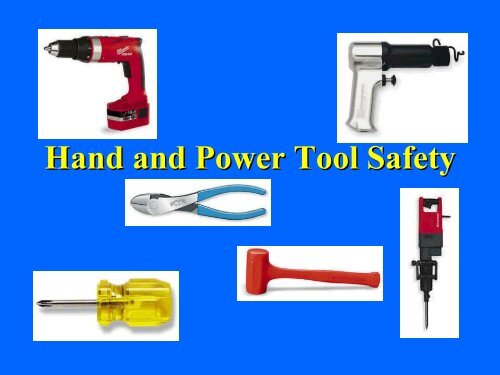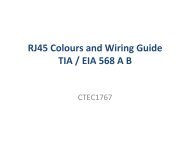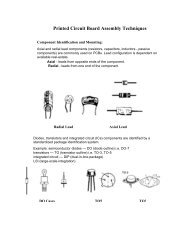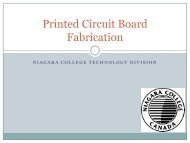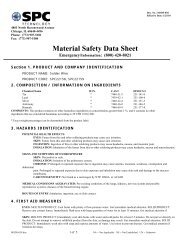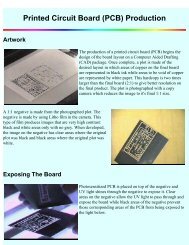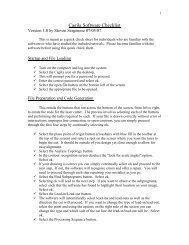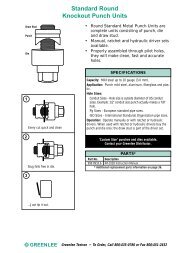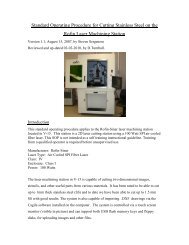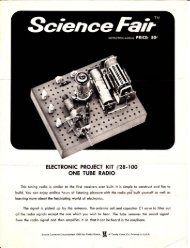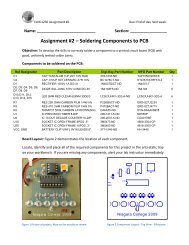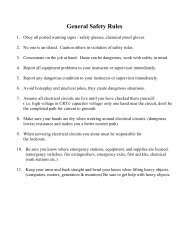Hand and Power Tool Safety - Technology
Hand and Power Tool Safety - Technology
Hand and Power Tool Safety - Technology
Create successful ePaper yourself
Turn your PDF publications into a flip-book with our unique Google optimized e-Paper software.
✔ For General Industry<br />
✔1910 Subpart P, <strong>H<strong>and</strong></strong> <strong>and</strong> Portable <strong>Power</strong> <strong>Tool</strong>s <strong>and</strong><br />
Other <strong>H<strong>and</strong></strong>-Held Equipment.<br />
✔1910.241, Definitions.<br />
✔1910.242, <strong>H<strong>and</strong></strong> <strong>and</strong> portable powered tools <strong>and</strong><br />
equipment, general.<br />
✔1910.243, Guarding of portable powered tools.<br />
✔1910.244, Other portable tools <strong>and</strong> equipment.
✔ Each employer shall be responsible for the safe<br />
condition of tools <strong>and</strong> equipment used by<br />
employees, including tools <strong>and</strong> equipment which<br />
may be furnished by employees.<br />
✔ Compressed air used for cleaning. Compressed air<br />
shall not be used for cleaning purposes except<br />
where reduced to less than 30 p.s.i. <strong>and</strong> then only<br />
with effective chip guarding <strong>and</strong> personal<br />
protective equipment.
✔ Employers shall not issue or permit the use of<br />
unsafe h<strong>and</strong> tools.<br />
✔ Wrenches, including adjustable, pipe, end, <strong>and</strong><br />
socket wrenches shall not be used when jaws are<br />
sprung to the point that slippage occurs.<br />
✔ Impact tools, such as drift pins, wedges, <strong>and</strong><br />
chisels, shall be kept free of mushroomed heads.<br />
✔ The wooden h<strong>and</strong>les of tools shall be kept free of<br />
splinters or cracks <strong>and</strong> shall be kept tight in the<br />
tool.
✔ Employees who use h<strong>and</strong> <strong>and</strong> power tools <strong>and</strong> who<br />
are exposed to the hazards of falling, flying, abrasive<br />
<strong>and</strong> splashing objects, or exposed to harmful dusts,<br />
fumes, mists, vapors, or gases must be provided with<br />
the particular personal equipment necessary to protect<br />
them from the hazard.<br />
✔ Employees <strong>and</strong> employers have a responsibility to<br />
work together to establish safe working procedures. If<br />
a hazardous situation is encountered, it should be<br />
brought to the attention of the proper individual<br />
immediately.
✔ Appropriate personal protective equipment should be<br />
worn due to hazards that may be encountered while using<br />
portable power tools <strong>and</strong> h<strong>and</strong> tools.<br />
✔ Floors should be kept as clean <strong>and</strong> dry as possible to<br />
prevent accidental slips with or around dangerous h<strong>and</strong><br />
tools.
✔ <strong>H<strong>and</strong></strong> tools are non-powered. They include<br />
anything from axes to wrenches. The greatest<br />
hazards posed by h<strong>and</strong> tools result from misuse<br />
<strong>and</strong> improper maintenance.
✔ The greatest hazards posed by h<strong>and</strong> tools result from<br />
misuse <strong>and</strong> improper maintenance.<br />
✔ Some examples:<br />
✔ Using a screwdriver as a chisel may cause the tip of the<br />
screwdriver to break <strong>and</strong> fly, hitting the user or other<br />
employees.<br />
✔ If a wooden h<strong>and</strong>le on a tool such as a hammer or an axe is<br />
loose, splintered, or cracked, the head of the tool may fly off<br />
<strong>and</strong> strike the user or another worker.<br />
✔ A wrench must not be used if its jaws are sprung, because it<br />
might slip.<br />
✔ Impact tools such as chisels, wedges, or drift pins are unsafe if<br />
they have mushroomed heads. The heads might shatter on<br />
impact, sending sharp fragments flying.
✔ The employer is responsible for the safe condition<br />
of tools <strong>and</strong> equipment used by employees but the<br />
employees have the responsibility for properly<br />
using <strong>and</strong> maintaining tools.<br />
✔ Employers should caution employees that saw<br />
blades, knives, or other tools be directed away<br />
from aisle areas <strong>and</strong> other employees working in<br />
close proximity. Knives <strong>and</strong> scissors must be<br />
sharp. Dull tools can be more hazardous than<br />
sharp ones.
✔ Around flammable substances, sparks produced by<br />
iron <strong>and</strong> steel h<strong>and</strong> tools can be a dangerous ignition<br />
source. Where this hazard exists, spark-resistant<br />
tools made from brass, plastic, aluminum, or wood<br />
will provide for safety.
✔ "Non-sparking", "spark-resistant" or "spark-proof" tools<br />
are names given to tools made of metals such as brass,<br />
bronze, Monel metal (copper-nickel alloy), copperaluminum<br />
alloys (aluminum bronze), copper-beryllium<br />
alloys (beryllium bronze), <strong>and</strong> titanium.<br />
✔ Preferred "non-sparking" metals have less tensile strength<br />
than steels usually used to make tools. A lower tensile<br />
strength means the metal has less strength or resistance to<br />
tearing apart when stretched under test conditions.<br />
✔ It also means that these tools are softer, wear down more<br />
quickly than ordinary steel tools, <strong>and</strong> have to be dressed<br />
more frequently.
✔ Offer more power, adaptability <strong>and</strong> dependability<br />
than ever before.<br />
✔ With enhanced tool performance comes the<br />
responsibility to address power-tool safety issues.<br />
✔ Maintenance management professionals <strong>and</strong><br />
technicians responsible for specifying <strong>and</strong> using<br />
power tools have a responsibility to check out a<br />
tool's safety features, then ensure that<br />
manufacturer safety precautions <strong>and</strong> common<br />
sense are followed at all times.
✔ All hazards involved in the use of power tools can<br />
be prevented by following five basic safety rules:<br />
✔Keep all tools in good condition with regular<br />
maintenance.<br />
✔Use the right tool for the job.<br />
✔Examine each tool for damage before use.<br />
✔Operate according to the manufacturer's<br />
instructions.<br />
✔Provide <strong>and</strong> use the proper protective equipment.
✔ The following information offers general safety<br />
guidelines for power tools<br />
✔ Individual manufacturers' tool owner/operator<br />
manuals, shipped with tools <strong>and</strong> accessories, are<br />
recommended as a final source for proper<br />
procedures for specific tool use.
✔ Know the power tool.<br />
✔Operators must read <strong>and</strong> underst<strong>and</strong> the owner's<br />
manual.<br />
✔Labels affixed or included in the shipping container<br />
must be read <strong>and</strong> understood.<br />
✔ Ground all tools unless double insulated.<br />
✔ Avoid dangerous environments. Do not use power<br />
tools in a damp, wet <strong>and</strong>/or explosive atmosphere<br />
-- fumes, dust or flammable materials.
✔ Be aware of all power lines <strong>and</strong> electrical circuits, water<br />
pipes, <strong>and</strong> other mechanical hazards in your work area,<br />
particularly those below the work surface, hidden from<br />
the operator's view, that may be contacted.<br />
✔ Wear proper apparel. Do not wear loose<br />
clothing, dangling objects or jewelry. Long<br />
hair must be restrained. Gloves should not be<br />
worn when operating certain power tools.<br />
Check appropriate tool manuals.
✔ <strong>Power</strong> tools can be hazardous when improperly<br />
used.<br />
✔ There are several types of power tools, based on<br />
the power source they use:<br />
✔electric, pneumatic, liquid fuel, hydraulic, <strong>and</strong> powderactuated.<br />
✔ Employees should be trained in the use of all tools<br />
- not just power tools. They should underst<strong>and</strong> the<br />
potential hazards as well as the safety precautions<br />
to prevent those hazards from occurring.
✔ The following general precautions should be<br />
observed by power tool users:<br />
✔ Never carry a tool by the cord or hose.<br />
✔ Never yank the cord or the hose to disconnect it<br />
from the receptacle.<br />
✔ Keep cords <strong>and</strong> hoses away from heat, oil, <strong>and</strong><br />
sharp edges.<br />
✔ Disconnect tools when not in use, before<br />
servicing, <strong>and</strong> when changing accessories such as<br />
blades, bits <strong>and</strong> cutters.
✔ All observers should be kept at a safe distance away<br />
from the work area.<br />
✔ Secure work with clamps or a vise, freeing both<br />
h<strong>and</strong>s to operate the tool.<br />
✔ Avoid accidental starting. Workers should not hold<br />
a finger on the switch button while carrying a<br />
plugged-in tool.
✔ <strong>Tool</strong>s should be maintained with care. They should<br />
be kept sharp <strong>and</strong> clean for the best performance.<br />
Follow instructions in the user's manual for<br />
lubricating <strong>and</strong> changing accessories.<br />
✔ Be sure to keep good footing <strong>and</strong> maintain good<br />
balance.<br />
✔ The proper apparel should be worn. Loose clothing,<br />
ties, or jewelry can become caught in moving parts.<br />
✔ All portable electric tools that are damaged shall be<br />
removed from use <strong>and</strong> tagged "Do Not Use."
✔ Employees using electric tools must be aware of<br />
several dangers; the most serious is the possibility<br />
of electrocution.<br />
✔ Among the chief hazards of electric-powered tools<br />
are burns <strong>and</strong> slight shocks which can lead to<br />
injuries or even heart failure.
✔ Under certain conditions, even a small amount of<br />
current can result in fibrillation of the heart <strong>and</strong><br />
eventual death.<br />
✔ A shock also can cause the user to fall off a ladder<br />
or other elevated work surface.
✔ Electric tools must either have a three-wire cord<br />
with ground <strong>and</strong> be grounded, be double insulated,<br />
or be powered by a low-voltage isolation<br />
transformer.<br />
✔ Double insulation is more convenient. The user<br />
<strong>and</strong> the tools are protected in two ways: by normal<br />
insulation on the wires inside, <strong>and</strong> by a housing<br />
that cannot conduct electricity to the operator in<br />
the event of a malfunction.
✔ These general practices should be followed when<br />
using electric tools:<br />
✔Electric tools should be operated within their design<br />
limitations.<br />
✔Gloves, if kept clear of rotating parts, <strong>and</strong> safety<br />
footwear are recommended during use of electric tools.<br />
✔When not in use, tools should be stored in a dry place.<br />
✔Electric tools should not be used in damp or wet<br />
locations.<br />
✔Work areas should be well lighted.
✔ There's a variety of accessories available for use<br />
on or with power tools.<br />
✔ Caution must be exercised when selecting <strong>and</strong><br />
using any accessory with any power tool.<br />
✔ Choosing the wrong accessory or using an<br />
accessory incorrectly can result in serious injury.
✔ Don't use an accessory or attachment unless:<br />
✔ The power tool manufacturer recommends its use on the<br />
product;<br />
✔ The accessory limitations <strong>and</strong> specifications -- such as speed,<br />
size, mounting <strong>and</strong> guarding requirements, etc. -- match the<br />
limitations <strong>and</strong> specifications of the power tool as shown in the<br />
owner/operator's manual; <strong>and</strong>,<br />
✔ The use of accessory does not require the removal of or<br />
defeating of any guards, barriers or other safety-related devices<br />
on the power tool, unless they are replaced by other appropriate<br />
guards or protective devices.<br />
✔ Unplug tools before installing, adjusting <strong>and</strong> changing any<br />
accessory or attachment of any kind.
✔ <strong>Power</strong>ed abrasive grinding, cutting, polishing, <strong>and</strong><br />
wire buffing wheels create special safety problems<br />
because they may throw off flying fragments.<br />
✔ Before an abrasive wheel is mounted, it should be<br />
inspected closely <strong>and</strong> sound- or ring-tested to be<br />
sure that it is free from cracks or defects.<br />
✔ To test, wheels should be tapped gently with a<br />
light non-metallic instrument. If they sound<br />
cracked or dead, they could fly apart in operation<br />
<strong>and</strong> so must not be used. A sound <strong>and</strong> undamaged<br />
wheel will give a clear metallic tone or "ring."
✔ Failure to ring test could<br />
result in a disintegrating<br />
wheel.<br />
✔ This could lead to serious<br />
injury or death.<br />
Spindle guard removed for better viewing
✔ To prevent the wheel from cracking, the user should<br />
be sure it fits freely on the spindle.<br />
✔ The spindle nut must be tightened enough to hold the<br />
wheel in place, without distorting the flange.<br />
✔ Follow the manufacturer's recommendations. Care<br />
must be taken to assure that the spindle wheel will not<br />
exceed the abrasive wheel specifications.<br />
✔ Due to the possibility of a wheel disintegrating<br />
(exploding) during start-up, the employee should<br />
never st<strong>and</strong> directly in front of the wheel as it<br />
accelerates to full operating speed.
✔ Portable grinding tools need to be equipped with<br />
safety guards to protect workers not only from the<br />
moving wheel surface, but also from flying<br />
fragments in case of breakage.<br />
✔ In addition, when using a powered grinder:<br />
✔Always use eye protection.<br />
✔Turn off the power when not in use.<br />
✔Never clamp a h<strong>and</strong>-held grinder in a vise.
✔ Among professionals, the circular saw is probably<br />
the most commonly used power saw <strong>and</strong> perhaps<br />
the most commonly abused.<br />
✔ Familiarity should not breed carelessness.<br />
✔ The following are specific safety musts when<br />
using any portable circular saws.
✔ Always wear safety goggles or safety glasses with<br />
side shields complying with the current national<br />
st<strong>and</strong>ard <strong>and</strong> a full face shield when needed. Use a<br />
dust mask in dusty work conditions. Wear hearing<br />
protection during extended periods of operation.<br />
✔ Don't wear loose clothing, jewelry or dangling<br />
objects, including long hair, that may catch in<br />
rotating parts or accessories.<br />
✔ Don't use a circular saw that is too heavy for you<br />
to easily control.
✔ Be sure the switch actuates properly. It should turn<br />
the tool on <strong>and</strong> return to the off position after release.<br />
✔ Use sharp blades. Dull blades cause binding, stalling<br />
<strong>and</strong> possible kickback. They also waste power <strong>and</strong><br />
reduce motor <strong>and</strong> switch life.<br />
✔ Use the correct blade for the application. Check this<br />
carefully. Does it have the proper size <strong>and</strong> shape<br />
arbor hole? Is the speed marked on the blade at least<br />
as high as the no-load RPM on the saw's nameplate?
✔ Is the blade guard working? Check for proper operation<br />
before each cut. Check often to ensure that guards return<br />
to their normal position quickly. If a guard seems slow to<br />
return or hangs up, repair or adjust it immediately. Never<br />
defeat the guard to expose the blade by, for example,<br />
tying it back or removing it.<br />
✔ Before starting a circular saw, be sure the power cord <strong>and</strong><br />
extension cord are out of the blade path <strong>and</strong> are long<br />
enough to freely complete the cut. Keep aware of the cord<br />
location. A sudden jerk or pulling on the cord can cause<br />
loss of control of the saw <strong>and</strong> a serious accident.
✔ For maximum control, hold the saw firmly with both<br />
h<strong>and</strong>s after securing the workpiece. Clamp workpieces.<br />
Check frequently to be sure clamps remain secure.<br />
✔ Avoid cutting small pieces that can't be properly secured<br />
<strong>and</strong> material on which the saw shoe can't properly rest.<br />
✔ When you start the saw, allow the blade to reach full<br />
speed before contacting the workpiece.<br />
✔ When making a partial cut, or if power is interrupted,<br />
release the trigger immediately <strong>and</strong> don't remove the saw<br />
until the blade has come to a complete stop.
✔ Available in a variety of types <strong>and</strong> capacities,<br />
portable power drills are undoubtedly the most<br />
used power tools.<br />
✔ Because of their h<strong>and</strong>iness <strong>and</strong> application to a<br />
wide range of jobs, drills often receive heavy use.<br />
✔ For this reason, you'll need to check with care<br />
your drill's capacity limitations <strong>and</strong> accessory<br />
recommendations.
✔ Check carefully for loose power cord connections<br />
<strong>and</strong> frays or damage to the cord. Replace damaged<br />
tool <strong>and</strong> extension cords immediately.<br />
✔ Be sure the chuck is tightly secured to the spindle.<br />
This is especially important on reversible type<br />
drills.<br />
✔ Tighten the bit securely as prescribed by the<br />
owner/operator's manual. The chuck key must be<br />
removed from the chuck before starting the drill.<br />
A flying key can be an injury-inflicting missile.
✔ Check auxiliary h<strong>and</strong>les, if part of the tool. Be sure they<br />
are securely installed. Always use the auxiliary drill<br />
h<strong>and</strong>le when provided. It gives you more control of the<br />
drill, especially if stalled conditions occur. Grasp the drill<br />
firmly by insulated surfaces.<br />
✔ Always hold or brace the tool securely. Brace against<br />
stationary objects for maximum control. If drilling in a<br />
clockwise -- forward -- direction, brace the drill to<br />
prevent a counterclockwise reaction.<br />
✔ Don't force a drill. Apply enough pressure to keep the<br />
drill bit cutting smoothly. If the drill slows down, relieve<br />
the pressure. Forcing the drill can cause the motor to
✔ Because of the saw's downward cutting motion, stay<br />
alert to keeping h<strong>and</strong>s <strong>and</strong> fingers away from the<br />
blade's path.<br />
✔ Be sure all guards are in place <strong>and</strong> working. If a<br />
guard seems slow to return to its normal position,<br />
adjust or repair it immediately.<br />
✔ Use only recommended size <strong>and</strong> RPM rated blades.<br />
✔ When installing or changing a blade, be sure the<br />
blade <strong>and</strong> related washers <strong>and</strong> fasteners are<br />
correctly positioned <strong>and</strong> secured on the saw arbor.
✔ Pneumatic tools are powered by compressed air <strong>and</strong><br />
include chippers, drills, hammers, <strong>and</strong> s<strong>and</strong>ers.<br />
✔ There are several dangers encountered in the use of<br />
pneumatic tools.<br />
✔ The main one is the danger of getting hit by one of<br />
the tool's attachments or by some kind of fastener<br />
the worker is using with the tool.<br />
✔ Eye protection is required <strong>and</strong> face protection is<br />
recommended for employees working with<br />
pneumatic tools.
✔ <strong>Tool</strong> retainer. A tool retainer shall be installed on<br />
each piece of utilization equipment which, without<br />
such a retainer, may eject the tool.<br />
✔ Airhose. Hose <strong>and</strong> hose connections used for<br />
conducting compressed air to utilization<br />
equipment shall be designed for the pressure <strong>and</strong><br />
service to which they are subjected.
✔ Pneumatic power tools shall be secured to the hose or<br />
whip by some positive means to prevent the tool from<br />
becoming accidentally disconnected.<br />
✔ <strong>Safety</strong> clips or retainers shall be securely installed <strong>and</strong><br />
maintained on pneumatic impact (percussion) tools to<br />
prevent attachments from being accidentally expelled.<br />
✔ All pneumatically driven nailers, staplers, <strong>and</strong> other<br />
similar equipment provided with automatic fastener feed,<br />
which operate at more than 100 p.s.i. pressure at the tool<br />
shall have a safety device on the muzzle to prevent the<br />
tool from ejecting fasteners, unless the muzzle is in<br />
contact with the work surface.
✔ The manufacturer's safe operating pressure for<br />
hoses, pipes, valves, filters, <strong>and</strong> other fittings shall<br />
not be exceeded,<br />
✔ The use of hoses for hoisting or lowering tools<br />
shall not be permitted.<br />
✔ All hoses exceeding 1/2-inch inside diameter shall<br />
have a safety device at the source of supply or<br />
branch line to reduce pressure in case of hose<br />
failure.
✔ Noise is another hazard. Working with noisy tools<br />
such as jackhammers requires proper, effective<br />
use of hearing protection.<br />
✔ When using pneumatic tools, employees must<br />
check to see that they are fastened securely to the<br />
hose to prevent them from becoming<br />
disconnected.<br />
✔ A short wire or positive locking device attaching<br />
the air hose to the tool will serve as an added<br />
safeguard.
✔ A safety clip or retainer must be installed to<br />
prevent attachments, such as chisels on a chipping<br />
hammer, from being unintentionally shot from the<br />
barrel.<br />
✔ Screens must be set up to protect nearby workers<br />
from being struck by flying fragments around<br />
chippers, riveting guns, staplers, or air drills.<br />
✔ Compressed air guns should never be pointed<br />
toward anyone. Users should never "dead-end" it<br />
against themselves or anyone else.
✔ Using pneumatic tools requires an efficient<br />
compressor system to adequately power the tools.<br />
✔ Several basic guidelines should be followed to<br />
insure efficient <strong>and</strong> continued operation of the<br />
compressor.
1. Before making or breaking any air connection, always<br />
turn off the air supply. Use the valve to turn off the air -<br />
Never kink the hose as a shortcut! Kinking the hose may<br />
damage or even rupture the air hose.<br />
2. Protect the air hose from damage. Move it out of the way<br />
of vehicles so that it isn't run over. Also, be sure not to<br />
drag hoses around sharp corners.<br />
3. Be sure to use the proper size air hose <strong>and</strong> fittings to keep<br />
air pressure at a maximum throughout the entire line.<br />
Most manufacturers recommend 90 psi at the tool.
4. To ensure the best connection, clear any dirt off the<br />
nipple before connecting the air hose to the tool.<br />
5. When the tool is connected, check the hose <strong>and</strong> all<br />
connections for leaks or damage before using the tool.<br />
6. Maintain a clean, dry, regulated source of air to<br />
operate air tools at peak performance. Filters,<br />
regulators, <strong>and</strong> lubricators should be used to keep the<br />
air system working at its best.
✔ The most common problem is water in compressed air<br />
✔ All air contains a certain amount of moisture <strong>and</strong><br />
impurities which can cause problems when it condenses<br />
in the air. Condensed water vapor <strong>and</strong> dirt left in the air<br />
line may result in the following problems:<br />
✔ Sluggish tool operation, <strong>and</strong> more frequent repair <strong>and</strong><br />
replacement of parts<br />
✔ Poor results in spraying <strong>and</strong> other types of finishing work<br />
✔ Washing away of required lubricants<br />
✔ Moisture left in lines exposed to cold weather may freeze<br />
<strong>and</strong> obstruct proper air flow


